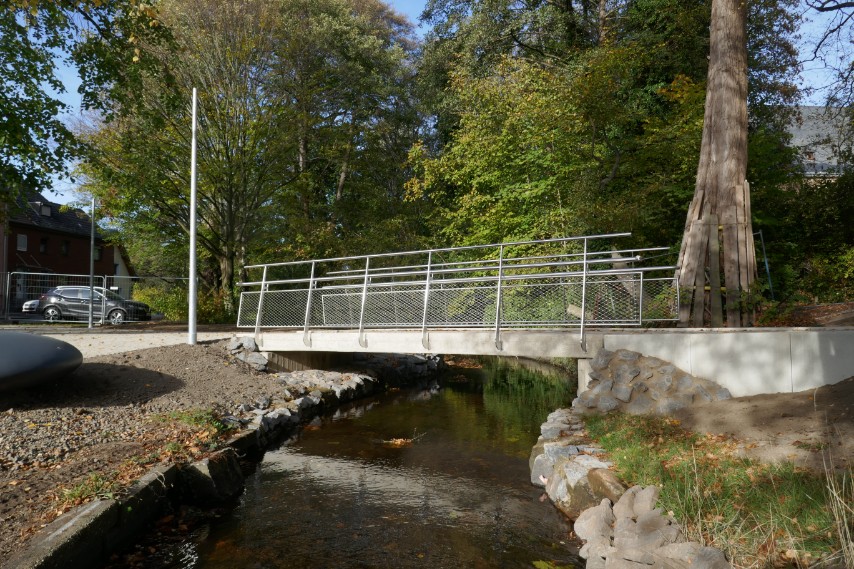Mots clés
Infrastructures innovantes pour demain : deux ponts en béton de carbone à Kreuzau
À Kreuzau, deux nouvelles passerelles piétonnes et cyclables ont été construites en béton de carbone, l'un des matériaux de construction les plus avancés actuellement disponibles. Ce projet allie technologie de pointe et pratiques de construction durables et constitue un projet pilote national de construction de ponts à armature textile.
Les ponts relient non seulement les deux rives du Mühlenteich, mais allient également tradition et innovation. Ils font partie du corridor récréatif « RurUfer-Radweg » et sont des symboles visibles d'infrastructures publiques respectueuses du climat et économes en ressources.
Détails du projet
- Entrepreneur général : Hans Graf Bauunternehmung GmbH & Co. KG
- Planification et ingénierie structurelle : Bureau d'études Cornelissen + Partner
- Soutien scientifique : Université RWTH d'Aix-la-Chapelle (IMB)
Détails techniques
Les deux ponts ont été entièrement construits à partir d'éléments préfabriqués en béton de carbone – une approche unique au monde pour les ponts publics de ce type. Le système innovant VariBridge a été utilisé, basé sur des éléments de pont modulaires produits hors site et assemblés rapidement sur place.
- Type de pont : Pont à poutres à travée unique
- Portée par pont : environ 12 mètres
- Largeur utile : 3,00 mètres
- Capacité de charge : jusqu'à 3,5 tonnes (véhicules d'entretien légers)
- Roulements : Roulements élastomères
- Fondations : Fondation superficielle, intégrée aux voies existantes
- Béton : Béton haute performance à granulométrie fine
- Renfort : Renfort en carbone solidian GRID Q95-CCE-38
- Surface : Asphalte coulé antidérapant sur membrane d'étanchéité
Faits clés
| Application | Ponts |
| Produits utilisés | |
| Année | 2023 |
| Lieu | Kreuzau, Allemagne |
| Projet | Façade en béton à double courbure et forme libre, passant du mur vertical à la toiture. |
Avantages
1. Durability and Corrosion Resistance
Carbon concrete is entirely resistant to environmental influences such as moisture or de-icing salts. This ensures an exceptional service life of over 100 years with minimal maintenance.
2. Resource Efficiency and Sustainability
Eliminating the need for thick concrete covers and using lightweight carbon reinforcement significantly reduces material consumption and the structure’s CO₂ footprint.
3. Slender Construction
The bridge elements feature a very low structural depth, offering aesthetic benefits while ensuring high load-bearing capacity and seamless integration into the surrounding landscape.
4. Fast Installation with Prefabricated Elements
The complete load-bearing structures were manufactured off-site and assembled on location in a matter of days.
Design and Architectural Considerations
The bridges were designed to integrate harmoniously into the natural environment around the Mühlenteich. Clean lines, a filigree silhouette and a slender underside create a modern, subtle appearance. The light concrete surface also improves visibility in poor lighting conditions – an added value in terms of safety and design. The new carbon concrete bridges in Kreuzau are a flagship example of future-oriented bridge construction. By combining industrial prefabrication, innovative materials and efficient construction techniques, the project sets new standards in public infrastructure.
Images: © Ingenieurbüro Cornelissen + Partner und USCHI KITSCHKE FOTOGRAFIE












